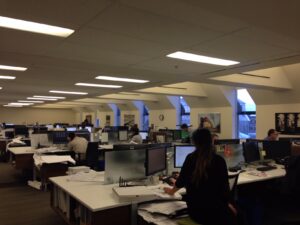 When we talk about culture we often refer to how work gets done. Today, I’d like to explore where that work gets done. Does your office building provide amazing support or is it just a contained place to congregate?
When we talk about culture we often refer to how work gets done. Today, I’d like to explore where that work gets done. Does your office building provide amazing support or is it just a contained place to congregate?
Whenever I think about culture and the physical work space, I recall the time I attended a Board meeting in Toronto. It was being held at the new offices of Corus Entertainment on the waterfront. I hopped out of the taxi and there before me was an eight story, all glass building. The automatic sliding doors opened into a tall, bright space where you could see right through to Lake Ontario at the back of the building. A small information desk welcomed me. A quick check-in resulted in an “ambassador” greeting me and guiding me to me to the glass enclosed meeting room.
When I returned to my own office, the contrast couldn’t have been more different. The entrance way was confined with swipe card required turnstiles and a formal security sign in desk. There were floors and floors of cubicles and vault like meeting rooms. It was definitely designed to maximize density. Not that one office was better than the other, but the “feel”, the message about the culture was poles apart.
The Workplace Fundamentals
When taking your physical work space into consideration there are two aspects that must be considered. The first is to account for the different types of work our employees engage in every day. The second is how to translate the core of your culture into the elements of the furniture, walls, and flooring.
Four types of work mode:
1. Focus: Basex, an American research firm, indicates that the average employee spends 28% of their time dealing with interruptions. And yet, these same employees recorded that 58% of their work requires them to individually focus for long periods of time. Large open spaces just aren’t conducive for maximizing outputs for this type of work. Consider incorporating small cubbies with sound absorbing acoustic furniture and “quiet” zones that allow employees to focus and get absorbed in their work.
2. Collaboration: The whole idea behind the open office concept was to increase collaboration and team alignment. However, since employees don’t spend 100% of their time collaborating, does it really make sense to lock them into this kind of environment for 100% of their workday? Creating spaces where people can authentically come together, with readily available technology that supports brainstorming, will generate better group efforts. Consider appropriate spaces for small group work which can easily be augmented for bigger teams.
3. Learning: In today’s Knowledge Economy professional development is key. This development can be delivered in a town hall group setting or through self-study or any other training delivery method in between. Having an adaptable space that can be set up as a classroom or comfortable informal learning pods encourages employees to engage in learning opportunities.
4. Socialization: The pressure at work can be intense. In order to be most productive, employees need to take breaks and regenerate. I love Dr. Posner’s analogy of high performing hockey teams. Each player takes a 30 second shift and then returns to the bench to rest. There are intermissions between periods, days between games, and finally a long break before the next season. How can you create spaces that will encourage employees to take a rest from work and either engage in solitary walks in nature or socialize with co-workers? One way to do this is to use a mix of bar top tables, diner style booths, or casual occasional table with couches and chairs. It’s about creating the neighborhood Starbucks experience.
Incorporating culture into the physical space
The best office designers spend time researching their client’s culture. Is family important? If so, how do we build that family feel into the furniture elements? Is innovation critical? How do we use colour, texture and layout to inspire invention?
How is your building working for you? Corus says their building has “revolutionized how Corus delivers its technical product and at the same time the building has transformed the way the Corus’ team works.”


